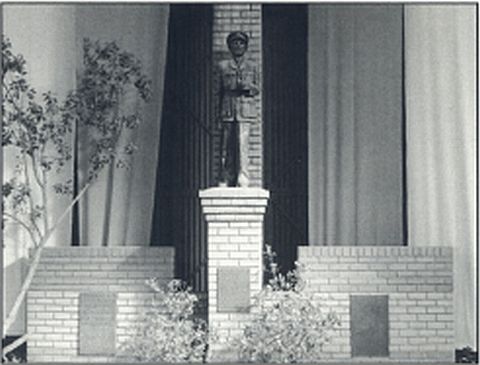

 The South African
The South African
The Dan Pienaar Statue is a central feature of the Dan Pienaar Gun Park. It is a 1,85m bronze statue of the man, standing with his binoculars in one hand and a walking stick in the other. This statue was originally situated on the second floor balcony of the Jimmy O'Connor Welfare Services Club in the Malvern suburb of Johannesburg. There it served as a memorial to the residents of the eastern districts of Johannesburg who had died on service during the war up until the end of 1943. When the club closed down in 1990, the statue was donated to the Museum. On 14 February 1992, at the official opening of the Dan Pienaar Gun Park, the statue was unveiled on its plinth by Mrs Norma Seuffert, his widow.

The Memorial comprises the statue and, at the base of its plinth, the two accompanying bronze plaques. The first plaque is a dedication to Maj Gen Dan Pienaar, which is inscribed: 'Eastern Districts Memorial to the late Major General Dan Pienaar CB, DSO and Bar who was killed on his way from the Middle East to the Union on the 19.12.1942 and to the men of the eastern areas of Johannesburg who have died in the World War. Cast by R Vignali - Pretoria North.' The second plaque lists the names of the 28 people to whom the memorial was dedicated.
The Foundry
There is an interesting history relating to the foundry where the statue was cast in 1944, R Vignali Foundry of Pretoria North. The foundry was established by Renzo Vignali (1903-1945), an Italian sculptor who had come to South Africa in 1931 on the recommendation of well-known South African sculptor, Anton van Wouw. Vignali had managed to obtain a number of commi$sions and chose to stay in Pretoria, where he was later joined by his wife and one year old daughter. In 1940, following the outbreak of the war, he was interned at Koffiefontein Camp, but was released after one month due to the fact that he been contracted to produce a sculpture of the former Prime Minister, Gen Louis Botha. This statue of Botha, showing him seated on his horse, is today located in the gardens of the Union Buildings in Pretoria.

As business grew, Vignali decided that he required help and made application for the services of Italian prisoners of war located at the Zonderwater POW Camp near Cullinan, east of Pretoria. His application was successful and six paws were placed at his disposal. One of these prisoners, Luigi Gambarini, took charge of the foundry after Vignali's untimely death in 1945. He later married Vignali's daughter, Gabriella, in 1960. Their two sons have continued to manage the business which is still located in Pretoria North today under the name 'Vignali R Artistic Foundry'.
The bronze statue of Pienaar, along with its adjoining plaques, is a fitting tribute, not only to the man himself, but also to the many South Africans who served under him and followed him through the trials and tribulations of the East African and North African campaigns of the Second World War. In its role as an historical memorial, it serves as a lasting testimony to the significant contributions made by South Africa in world history.
Return to Journal Index OR Society's Home page
South African Military History Society / scribe@samilitaryhistory.org